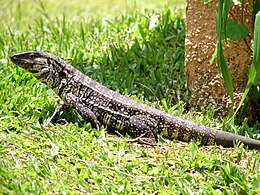This article needs additional citations for
verification. (June 2015) |

Tegu is a common name of a number of species of lizards that belong to the families Teiidae and Gymnophthalmidae. Tegus are native to Central and South America. They occupy a variety of habitats and are known for their large size and predatory habits. [1]
Description
Tegus are, usually, black mixed with other colors and patterns; some have yellow, reddish or white bands along their backs, others have lines going down their bodies with unique markings on their sides. Their body shape is aerodynamic with long tails and strong legs. Most tegus grow to about a metre long, but the black and white tegu (S. merianae) can grow to about 1.3 metres. [2]
Although, in appearance, tegus resemble the Varanidae (monitors), they are not closely related to them. Their initial similarities are an example of convergent evolution, when unrelated or distantly-related species develop physical or behavioral similarities based on ecological niche, adaptations or environment.
Tegus use their tongues and vomeronasal organ to find chemical cues associated with their prey and other lizards. A vomeronasal organ is an organ of chemoreception located in the nasal chamber. [2]
Habitat
Tegus naturally occur in rainforests, deciduous semiarid thorn forests, savannas, fields and grasslands. They have also adapted to open areas created by agriculture, parks and construction zones. They spend much of their time in burrows. [3]
Diet
As omnivores, tegus feed on various foods including fruits, insects, frogs, small rodents, birds, eggs and carrion. Tegus living near humans may raid chicken coops for eggs and baby chicks, or scavenge leftover food such as crackers, cheese and chips. [3]
Behaviour
When confronted, a wild tegu initially stops moving with its head held up high, then attempts to flee. It may turn aggressive if cornered, biting and attacking with its tail. In contrast, captive-raised tegus can be docile, intelligent and social with their carers. [3]
In the coolest areas of their range, such as northern Argentina, tegus hibernate from June to September. [3]
Endothermy
During the reproductive season, Argentine black and white tegus can raise their body temperature by up to 10 °C above the ambient temperature (seasonal reproductive endothermy). This may be advantageous when coming out of hibernation, regrowing gonads, producing gametes ( gametogenesis), mating, and (for females) producing eggs and incubating them. [4]
Importance
Tegus are traditionally hunted for their meat, fat, and hides. [5] [6]
Argentine black and white tegus are widely and successfully bred and kept as pets, with red tegus being slightly less common in the hobby but still present. [7] Additionally, Dracaena guianensis, the northern caiman lizard, is growing in popularity among breeders and hobbyists.
Some species have become invasive in the U.S. state of Florida [8] and southern parts of Georgia. [9]
Genera
"Tegu" generally refers to species of lizard in the genus Tupinambis, which belongs to the family Teiidae. Not all lizards known as tegus belong to the same genus. The word "tegu" may refer to species in any of the following genera:
- Callopistes: "dwarf tegus" (2 species)
- Crocodilurus: the "crocodile tegu" (1 species)
- Dicrodon: "desert tegus" (3 species)
- Dracaena: "caiman tegus", also known as "caiman lizards" (2 species)
- Euspondylus: "sun tegus" (11 species)
- Proctoporus: "sun tegus" (17 species)
- Salvator (3 species, including the Argentine black and white tegu)
- Teius (3 species, including the "four-toed tegu")
- Tupinambis (8 species)
References
- ^ "How huge pet South American tegu lizards are invading the US". The Telegraph. 2018-08-03. ISSN 0307-1235. Retrieved 2019-03-29.
- ^ a b "Tegu | lizard | Britannica". www.youtube.com. Retrieved 2023-01-24.
- ^ a b c d "Pantanal Escapes - Tegu". Pantanal Escapes. Retrieved 2023-01-24.
- ^ Tattersall, Glenn J.; Leite, Cleo A.C.; Sanders, Colin E.; Cadena, Viviana; Andrade, Denis V.; Abe, Augusto S.; Milsom, William K. (2016). "Seasonal reproductive endothermy in tegu lizards". Science Advances. 2 (1): e1500951. doi: 10.1126/sciadv.1500951. ISSN 2375-2548. PMC 4737272. PMID 26844295.
- ^ Mieres, M. Margarita; Fitzgerald, Lee A. (2006). "Monitoring and managing the harvest of tegu lizards in Paraguay". The Journal of Wildlife Management. 70 (6): 1723–1734. doi: 10.2193/0022-541X(2006)70[1723:MAMTHO]2.0.CO;2. ISSN 0022-541X. JSTOR 4128106. S2CID 27029533.
- ^ Caldironi, Hugo A.; Manes, Mario E. (2006). "Proximate composition, fatty acids, and cholesterol content of meat cuts from tegu lizard Tupinambis merianae". Journal of Food Composition and Analysis. 19 (6–7): 711–714. doi: 10.1016/j.jfca.2005.09.005. hdl: 11336/84972.
- ^ "Do Argentine black and white tegus make good pets?". The Spruce Pets. Retrieved 24 January 2023.
- ^ Nuwer, Rachel (4 August 2014). "A lizard interloper presents a challenge in Florida". The New York Times. ISSN 0362-4331. Retrieved 29 March 2019.
- ^ Maxouris, Christina (14 May 2020). "Georgia officials are asking the public to help them track 4 foot long, invasive lizards". CNN. Retrieved 15 May 2020.